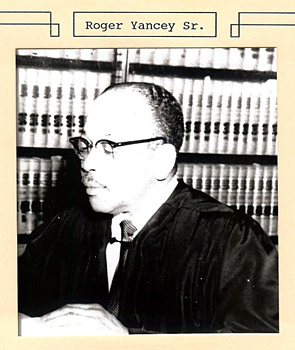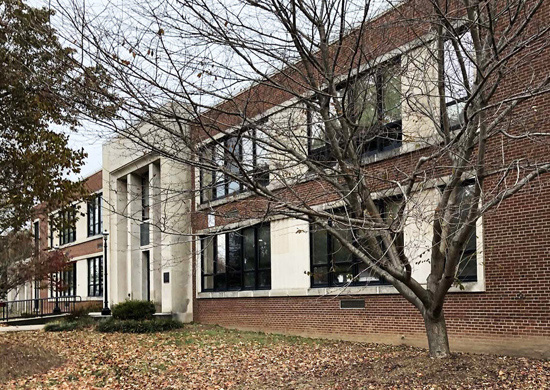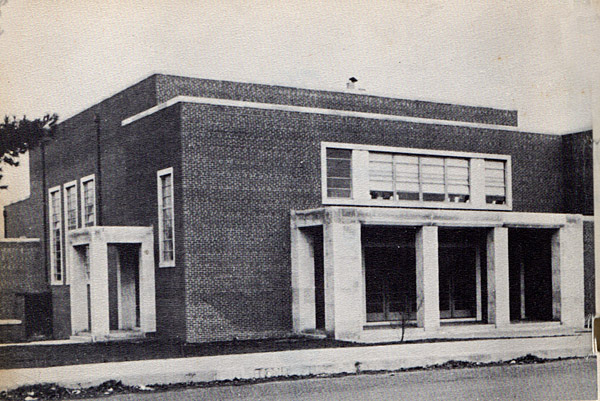|
Name: Jackson P. Burley School
Date: 1956
Image Number: Jackson P. Burley School Yearbook, 1956
Comments: In 1949, the Charlottesville School Board combined Jefferson High School, Esmont High School, and Albemarle Training School in Albemarle County,
black schools in Charlottesville and Albemarle County, into a single school for all the black students in grades 8-12 in the area. The city
purchased land from Jackson P. Burley, a teacher, church worker, and leader within the Charlottesville community, and constructed a new church on a
seventeen acre tract of land located on Rose Hill Drive in Charlottesville. Construction began on the site in 1950, and in 1961, Burley School
opened for classes with a total of 542 students enrolled in grades 8-12 in its first year of occupancy.
In June 1967, Burley ceased being an all black high school for city and county students. It became known as the Jack Jouett Junior Annex
and served as an over-flow school housing seventh graders from Jack Jouett Junior High.
To learn more about educational opportunities for blacks in the Esmont Community and Albemarle County before desegregation, please read the following
article by Maxwell Johnson:

Educational Opportunities for Blacks in Esmont and Albemarle County
Prior to Desegregation
by Maxwell Johnson
Educational opportunities for blacks in Albemarle County were generally poor before desegregation.
Well into the first half of the 20th century, it remained common for some students to stop their education after primary school. In addition,
public black high schools tended to push vocational education. This was due to segregationist policies that kept blacks out of positions of
economic power.
Since the government treated black schools as an afterthought, community involvement played a significant role in creating and supporting Esmont's
early schools. Local leaders formed an "Educational Board" in 1907, and residents raised money to fund new schools over the years.
Outside philanthropic entities, like the Jeanes Fund, which provided teachers to rural black schools, also helped.
Still, the students' needs were inadequately met. Older Esmont residents recall walking several miles to school, as school bus service for
blacks was either extremely limited or nonexistent. In the 1950's Dorothy Harris, an Esmont resident, attended Albemarle County's Jackson
P. Burley School, a consolidated black high school, and she recalls being unable to participate in after-school activities because Burley was
in Charlottesville, about twenty miles from Esmont. Dorothy would not have transportation home if she stayed late at Burley and missed
the departure of her bus. She especially lamented how rural kids could not get help with the college process from school counselors.
Those meetings occurred after school hours, and were more easily accessible for city kids who could walk home afterwards than for rural kids
whose homes dotted Albemarle County's vast expanse.
Students who went to college under segregation almost invariably attended black institutions like Virginia State College, Hampton Institute, and
St. Paul's (the first two are now universities and the last one is defunct). In those schools, African Americans learned to teach or
learned trades. Afterwards, the newly trained young adults returned to their home communities to raise the next generation, who would more
or less follow in the same cycle until desegregation. This approach formed a self-contained black society that ran parallel -
underprivileged and unequal - to white society.
 Some
of those who broke from the routine went north, which offered more socioeconomic opportunity. For example, Roger McKinley Yancey, born in
Esmont in 1902 to a prominent educator and his wife, graduated from Hampton Institute and went on study law at Rutgers University. In the
mid-1950's, New Jersey's then governor appointed Yancey judge for Essex County District Court. Such a career trajectory would have been
all but impossible for a black person like him in segregated Albemarle County. The Garden State Bar Association continue to give the
Roger M. Yancey Award for Outstanding Achievement in honor of his impressive career. Some
of those who broke from the routine went north, which offered more socioeconomic opportunity. For example, Roger McKinley Yancey, born in
Esmont in 1902 to a prominent educator and his wife, graduated from Hampton Institute and went on study law at Rutgers University. In the
mid-1950's, New Jersey's then governor appointed Yancey judge for Essex County District Court. Such a career trajectory would have been
all but impossible for a black person like him in segregated Albemarle County. The Garden State Bar Association continue to give the
Roger M. Yancey Award for Outstanding Achievement in honor of his impressive career.
Unforgettable: Jackson P. Burley High School, 1951-1967
by Evelyn Edson, 2021
Just out: a new book by Lucille Stout Smith (see above book cover) explores the history of Charlottesville's Black high school
that opened in 1951, consolidating Esmont Colored High School, Albemarle Training School, and Jefferson High School in a grand new brick building on Rose Hill Drive.
Entering the school for the first time, Bernard Washington (Class of 1952) said, "I was awe-struck by its size and brick structure. This reaction was
the result of attending the six-room, wooden Esmont High School built in 1916." Lloyd Feggans (Class of 1956) noted that the Esmont School had no
inside bathrooms or running water, "but happy students and caring teachers." Still "to go from Esmont High School to Jackson P. Burley was quite a
change for the better. I loved Burley High then, and I love it even more today."
 Jackson P. Burley High School, exterior front facade in 2019
Jackson P. Burley High School, exterior front facade in 2019
Photo by Maral Kalbian, 2019. Courtesy of Virginia Department of Historic ResourcesStudents praised the academic opportunities and the extra-curricular activities, such as the music program and
the famed sports team, the Burley Bears. The Bears played in the Virginia Interscholastic Association League that included all African-American high
schools in the commonwealth, and were champions in 1952, 1954, and 1957. The Smith Aquatic and Fitness Center on the Buford School grounds is named for
Bob Smith, coach of the Bears from 1951 to 1960.
"Burley had the hottest band in Charlottesville ... For any local parade, the Burley Band would be front and center in the line-up. But, organizers would
soon realize, they needed to place the Burley Band at the end of the parade, because, as they marched, the crowd would follow the band along the parade route and
would not remain to support the other parade participants." (p. 178, Unforgettable: Jackson P. Burley High School, 1951-1967).
With desegration Burley's glory days came to an end, and students were transferred to Lane and Albemarle High Schools. There was considerable culture shock.
One of the Burley cheerleaders found that tryouts had been held in the spring, and that she could not even be considered for the squad. After the warm,
supportive atmosphere of Burley, student transfers tried mightily to adjust to the new, White-majority schools where, they felt, "they stuck out like a sore
thumb." But Burley lives on in the heartfelt accounts here.
Unforgettable is packed with pictures and reminisences of students and faculty. The first printing rapidly sold out, but new copies will be
available soon at New Dominion Bookstore and the Jefferson Heritage Center. Contact the Burley Varsity Club at 434-825-6617 to order yours at $35.

Scottsville Museum wishes to thank Maxwell Johnson for his research and photographs on Jackson P. Burley HS in
Charlottesville which served Esmont community students.
References:
1) "Ashby named law aide in New Jersey." The Afro American, 7 July 1956.
2) Counterbalance. National Association of Women Judges. Vol. 31, Issue 7, 2014.
3) Esmont Oral History Project: Building Digital Communities, Race and Place: African American Community History,
Albemarle County, Virginia. Prepared by the Virginia Center for Digital History, Charlottesville, VA, 2001-2002.
4) Johnson, Maxwell, and Dorothy Harris. Interview of Dorothy Harris. 19 June 2018.
5) Williams, Wiley J. "Jeanes Fund." Neuse River | NCpedia, State Library of North Carolina, 2006.
6) "Woman Held In Death Of Judge; Widow Denies Accused Was Family Friend." JET, 2 March 1972.
7) Virginia Foundation for the Humanities. "Jackson P. Burley School." African American Historic Sites Database.
Copyright © 2021 by Scottsville Museum
Top Image Located On: Jackson P. Burley School Yearbook, 1956, Published by The Senior Class, Jackson P. Burley School,
Charlottesville, VA
Second Image Located On: FindAGrave, Roger McKinley Yancey, 1902-1972, New Hope Baptist Church Cemetery, Esmont, VA.
Third Image regarding Unforgettable is courtesy of the Burley Varsity Club.
Fourth Image of Jackson P. Burley High School, 2019, is by Maral Kalbian and courtesy of the Virginia Department of Historic Resources
|






 Jackson P. Burley High School, exterior front facade in 2019
Jackson P. Burley High School, exterior front facade in 2019